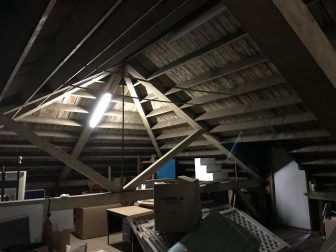Despite a town committee’s recommendation that the structure be re-used in some way, New Canaan Country School plans to demolish a large barn on its Frogtown Road campus, officials say.

Inside the barn at New Canaan Country School. Credit: Michael Dinan
The red-painted barn and adjacent row of smaller sheds are to be razed to make way for a new pool and pool house, school officials have said. The private school applied Aug. 1 for a demolition permit. After the town received a formal letter of objection, the New Canaan Historical Review Committee voted unanimously to impose a 90-day delay, its members saying they hoped the 4,500-square-foot barn could be re-used—for example, as part of the new pool house.
That is not to be, according to Country School Director of Marketing & Communications Brooke Arthur.
“Though we have studied the possible use of the barn on our campus, it is simply not feasible,” Arthur said in an email when asked about the school’s plans. “We do not plan to take down the barn for a couple of months and in the meantime continue to seek anyone interested in any parts of the barn in a potential relocation.”

The barn at New Canaan Country School. Credit: Michael Dinan
Committee members after visiting the ca. late-1800s barn said it was attractive and that its roof appeared to be in very good shape.
It isn’t clear how talks went between the parties. The Committee’s chairman could not be reached for comment.
In filing an objection letter, Mimi Findlay, a founder of the New Canaan Preservation Alliance, said the barn once was part of William Davenport’s farm.
Citing Mary Louise King’s history “A Portrait of New Canaan,” Findlay wrote in her objection letter, “King relates that the farm was purchased from foreclosure by the the New Canaan Savings Bank at the end of the century by the Grace Church in NYC.”
“They built the large building, now the campus centerpiece, to house women and children coming from the church’s unhealthy urban environment, part of the nationwide movement to escape disease and contagious epidemics by coming to the country. It coincides with the arrival of doctors in New Canaan establishing a sanitarium and practices here, and the arrival of summer visitors for health reasons. Its architect has not been publicly identified. The old barn would have been used at that time to house horses, carriages and wagons for the use of those living and working there. I am sure the children must have enjoyed playing in the hayloft.”


I would be interested in saving and salvaging the barn and its elements if that is something that is possible. If you could put me in contact with someone at Country School that would be appreciated